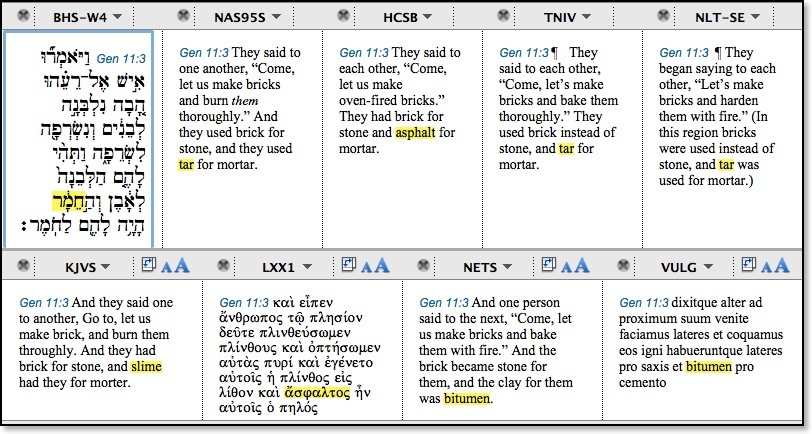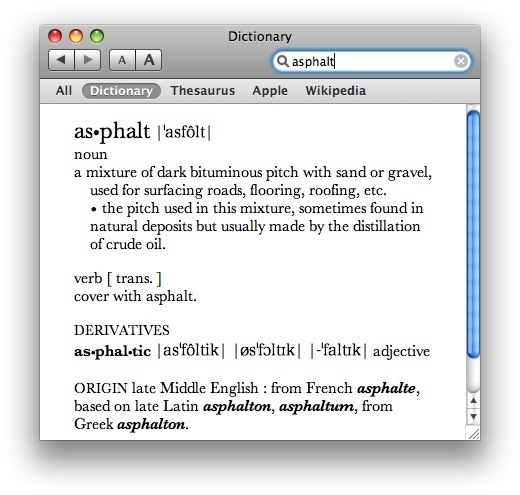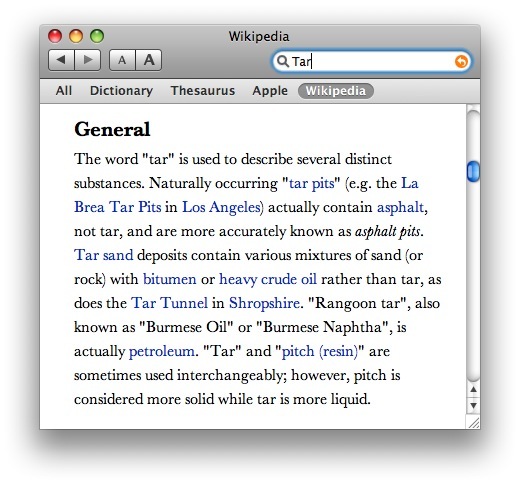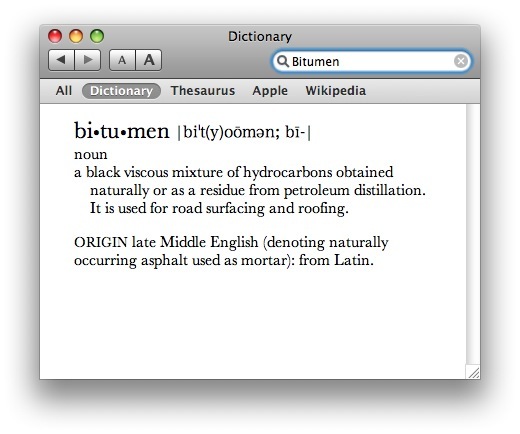Gen 11:3 -- Exactly What Kept the Bricks Together?
01/16/2008 21:02 Filed in: Faith & Reason
This past Sunday, in our Bible study class at church, we discussed Genesis 11 which includes the story of the Tower of Babel. I find verse 3 interesting because of the stuff used to hold the bricks together. There's no theology involved here, and any kind of "life application" would be severely stretching the text, but I found it interesting from a historical point of view. I found it interesting because our curriculum teaching guide noted that the stones in the tower were held together by "asphalt created by exposing the plentiful crude oil in the region to the air." Crude oil? Yep, the old black gold, Texas tea.
I mentioned this fact to my class and asked for a brief survey of translations for this stuff between the bricks. I received a lot of tar, one or two instances of asphalt, an isolated bitumen, and then one fellow reading from the King James Version said his translation read slime.

The above screenshot from Accordance displays a few major translations along with original language texts. Due to the Limitations of RapidWeaver, I'll have to transliterate, but the word in question in the Hebrew is chemar. This specific form of the word only occurs in Gen 11:3; 14:10 and Exod 2:3. It's defined in the HALOT as "bitumen, asphalt." But what exactly is that?
First, let's look at the odd man here: the KJV's use of slime. It's frankly a surprising translation to me, and not a very good one. Perhaps someone can provide insight to the KJV translators' choice for this rendering based on older definitions of the word. I wondered initially if there was any connection with the word slime to some kind of Latin meaning. But according to the American Heritage Dictionary on my MacBook, our word slime comes from the Old English slīm which is related to Dutch slijm and German Schleim ‘mucus, slime,’ Latin limus ‘mud,’ and Greek limnē ‘marsh.’ I looked in the Vulgate since the KJV translators often looked there when they were unsure about a word's meaning, but the Vulgate actually reads bitumen. Interesting.
 The HCSB renders chemar as "asphalt." Upon first glance, I felt that word asphalt sounded too modern, but I was mistaken. It's not a modern word at all, but a very ancient one. In fact, that's the very word (ἄσφαλτος/asphaltos) that is used in the LXX (although note that the New English Translation of the Septuagint [NETS] transfers the word bitumen--go figure). But isn't asphalt the stuff they use to pave roads and parking lots? That still seems a bit too modern for Babel. But actually it's not. Note the definition for asphalt to the right. It states that it is "a mixture of dark bituminous [there's that word again] pitch with sand or gravel used for surfacing roads, flooring, roofing, etc." And then notice the sub-definition: "the pitch used in this mixture, sometimes found in natural deposits but usually made from the distillation of crude oil." Aha! We're back to the crude oil angle.
The HCSB renders chemar as "asphalt." Upon first glance, I felt that word asphalt sounded too modern, but I was mistaken. It's not a modern word at all, but a very ancient one. In fact, that's the very word (ἄσφαλτος/asphaltos) that is used in the LXX (although note that the New English Translation of the Septuagint [NETS] transfers the word bitumen--go figure). But isn't asphalt the stuff they use to pave roads and parking lots? That still seems a bit too modern for Babel. But actually it's not. Note the definition for asphalt to the right. It states that it is "a mixture of dark bituminous [there's that word again] pitch with sand or gravel used for surfacing roads, flooring, roofing, etc." And then notice the sub-definition: "the pitch used in this mixture, sometimes found in natural deposits but usually made from the distillation of crude oil." Aha! We're back to the crude oil angle.
So, although it still sounds a bit odd to my ear, asphalt turns out to be an okay definition. But what about tar which so many translations use? I also associate tar with roads, and I also think of the old tar baby in the Uncle Remus stories. But what exactly is tar? Tar is defined as "a dark, thick, flammable liquid distilled from wood or coal, consisting of a mixture of hydrocarbons, resins, alcohols, and other compounds. It is used in roadmaking and for coating and preserving timber." We have that roadmaking connection to the asphalt, but there's no mention of crude oil here. Is tar a valid translation?
 Well, there's tar, and then, it seems, there's tar. I hate to admit it, but sometimes I actually find information of value in the Wikipedia. In the general article on tar, it says that naturally occurring pits (the ones that swallowed up the saber-toothed cats and wooly mammoths) don't contain the stuff defined as tar above, but actually contain asphalt. What's more, we shouldn't call them "tar pits," but "asphalt pits" (from now on make all references to the "La Brea asphalt pits"). The article further says that "Tar sand deposits contain various mixtures of sand (or rock) with bitumen or heavy crude oil rather than tar... ." So, technically, while tar is often used to refer to the kind of stuff referenced in Gen 11:3, it's not actually tar by the strict definition of the word but instead this substance known as asphalt or bitumen or heavy crude oil.
Well, there's tar, and then, it seems, there's tar. I hate to admit it, but sometimes I actually find information of value in the Wikipedia. In the general article on tar, it says that naturally occurring pits (the ones that swallowed up the saber-toothed cats and wooly mammoths) don't contain the stuff defined as tar above, but actually contain asphalt. What's more, we shouldn't call them "tar pits," but "asphalt pits" (from now on make all references to the "La Brea asphalt pits"). The article further says that "Tar sand deposits contain various mixtures of sand (or rock) with bitumen or heavy crude oil rather than tar... ." So, technically, while tar is often used to refer to the kind of stuff referenced in Gen 11:3, it's not actually tar by the strict definition of the word but instead this substance known as asphalt or bitumen or heavy crude oil.
 A number of translations not represented in the original Accordance box above actually render the Hebrew word chemar as "bitumen" (see for instance, RSV/NRSV/ESV, JPS, NJB, and REB). So, what then is bitumen? Going back to our American Heritage Dictionary, bitumen is defined as "a black viscous mixture of hydrocarbons contained naturally or as a residue from petroleum distillation. It is used for road surfacing and roofing." Sounds like tar and asphalt, doesn't it?
A number of translations not represented in the original Accordance box above actually render the Hebrew word chemar as "bitumen" (see for instance, RSV/NRSV/ESV, JPS, NJB, and REB). So, what then is bitumen? Going back to our American Heritage Dictionary, bitumen is defined as "a black viscous mixture of hydrocarbons contained naturally or as a residue from petroleum distillation. It is used for road surfacing and roofing." Sounds like tar and asphalt, doesn't it?
So, in the end, I believe tar, while not entirely incorrect, may not be the best rendering of chemar. Rather, bitumen or asphalt may be better choices. Bitumen is going to be a more unfamiliar word to most, I assume, but I wonder if asphalt still sounds too modern, even if it's really not?
One final point. The story of the Tower of Babel takes place, according to Gen 11:2, in the Valley of Shinar. Where exactly is that? The Anchor Bible Dictionary offers the answer:
"The meaning of Shinar is clear from the biblical references. It is the area known to the Mesopotamians as “the land of Sumer and Akkad,” corresponding to the portion of modern Iraq S[outh] of Baghdad. This meaning is confirmed by the LXX, Targum Onqelos, and the Genesis Apocryphon. All three sometimes translate “Shinar” as Babylon(ia)."
So, it's interesting that the first biblical reference to this region also refers to crude oil petroleum. It was a significant factor in life then, and it is even much more so today.
Sing it with me: "...black gold, Texas tea! Well, the first thing you know, Nimrod's a millionaire..."
I mentioned this fact to my class and asked for a brief survey of translations for this stuff between the bricks. I received a lot of tar, one or two instances of asphalt, an isolated bitumen, and then one fellow reading from the King James Version said his translation read slime.

The above screenshot from Accordance displays a few major translations along with original language texts. Due to the Limitations of RapidWeaver, I'll have to transliterate, but the word in question in the Hebrew is chemar. This specific form of the word only occurs in Gen 11:3; 14:10 and Exod 2:3. It's defined in the HALOT as "bitumen, asphalt." But what exactly is that?
First, let's look at the odd man here: the KJV's use of slime. It's frankly a surprising translation to me, and not a very good one. Perhaps someone can provide insight to the KJV translators' choice for this rendering based on older definitions of the word. I wondered initially if there was any connection with the word slime to some kind of Latin meaning. But according to the American Heritage Dictionary on my MacBook, our word slime comes from the Old English slīm which is related to Dutch slijm and German Schleim ‘mucus, slime,’ Latin limus ‘mud,’ and Greek limnē ‘marsh.’ I looked in the Vulgate since the KJV translators often looked there when they were unsure about a word's meaning, but the Vulgate actually reads bitumen. Interesting.

So, although it still sounds a bit odd to my ear, asphalt turns out to be an okay definition. But what about tar which so many translations use? I also associate tar with roads, and I also think of the old tar baby in the Uncle Remus stories. But what exactly is tar? Tar is defined as "a dark, thick, flammable liquid distilled from wood or coal, consisting of a mixture of hydrocarbons, resins, alcohols, and other compounds. It is used in roadmaking and for coating and preserving timber." We have that roadmaking connection to the asphalt, but there's no mention of crude oil here. Is tar a valid translation?


So, in the end, I believe tar, while not entirely incorrect, may not be the best rendering of chemar. Rather, bitumen or asphalt may be better choices. Bitumen is going to be a more unfamiliar word to most, I assume, but I wonder if asphalt still sounds too modern, even if it's really not?
One final point. The story of the Tower of Babel takes place, according to Gen 11:2, in the Valley of Shinar. Where exactly is that? The Anchor Bible Dictionary offers the answer:
"The meaning of Shinar is clear from the biblical references. It is the area known to the Mesopotamians as “the land of Sumer and Akkad,” corresponding to the portion of modern Iraq S[outh] of Baghdad. This meaning is confirmed by the LXX, Targum Onqelos, and the Genesis Apocryphon. All three sometimes translate “Shinar” as Babylon(ia)."
So, it's interesting that the first biblical reference to this region also refers to crude oil petroleum. It was a significant factor in life then, and it is even much more so today.
Sing it with me: "...black gold, Texas tea! Well, the first thing you know, Nimrod's a millionaire..."









